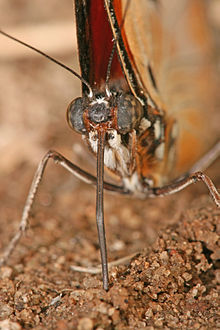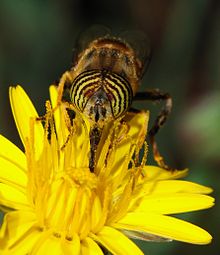This is an old revision of this page, as edited by TaintedMustard (talk | contribs) at 21:41, 6 February 2010 (removed vandalism by 99.67.21.66). The present address (URL) is a permanent link to this revision, which may differ significantly from the current revision.
Revision as of 21:41, 6 February 2010 by TaintedMustard (talk | contribs) (removed vandalism by 99.67.21.66)(diff) ← Previous revision | Latest revision (diff) | Newer revision → (diff) This article is about the mouth part. For the butterfly genus, see Proboscis (genus). For the monkey, see Proboscis monkey.



In general, a proboscis (from Greek προ, pro "before" and βοσκειν, boskein "to feed") is an elongated appendage from the head of an animal, either a vertebrate or an invertebrate.
Etymology
The correct Greek plural is proboscides, but in English it is more common to simply add -es, forming proboscises.
Although the word derives from the Greek "pro-boskein", the Latin spelling "proboscis" is taken in favor of the Greek "proboskis".
Invertebrates
The most common usage is to refer to the tubular feeding and sucking organ of certain invertebrates such as insects (e.g., moths and butterflies), worms (including proboscis worms) and gastropod molluscs.
Lepidoptera mouth parts
The mouth parts of Lepidoptera mainly consist of the sucking kind; this part is known as the proboscis or 'haustellum'.The proboscis consists of two tubes held together by hooks and separable or cleaning. The proboscis contains muscles for operating. Each tube is inardly concave, thus forming a central tube up which moiture is sucked. Suction takes place due to the contraction and expansion of a sac in the head.
A few Lepidoptera species lack mouth parts and therefor do not feed in the imago. Others, such as the family Micropterigidae, have mouth parts of the chewing kind.
Vertebrates
The elephant's trunk and the tapir's elongated nose are called "proboscis", as is the snout of the male elephant seal.
The Proboscis Monkey is named for its enormous nose, and an elongated human nose is sometimes facetiously called a proboscis.
An abnormal facial appendage that sometimes accompanies ocular and nasal abnormalities in humans is also called a proboscis.
Notable mammals with some form of proboscis are:
- Members of the elephant family (see elephant trunk).
- Moeritherium
- Macrauchenia
- Palorchestes
- Aardvark
- Tapiridae
- Elephant shrews
- Numbat
- Proboscis Monkey
See also
References
- "proboscis". Retrieved 2008-07-27.
- Evans, Identification of Indian Butterflies, Introduction, pp 1 to 35.
- Charles A. Triplehorn and Norman F. Johnson (2005). Borror and Delong's Introduction to the Study of Insects (7th edition). Thomson Brooks/Cole, Belmont, CA. ISBN 0-03-096835-6
This animal-related article is a stub. You can help Misplaced Pages by expanding it. |